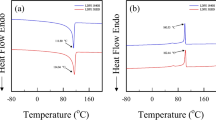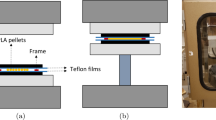Abstract
The thick bulk films of amorphous polystyrene (PS) and poly(ethylene terephthalate) (PET) were held in contact for various periods of healing time (t) of 5 min to 15 h at 3 constant healing temperatures T = 74 °C, 89 °C, and 108 °C ranging from below to above the bulk glass transition temperatures of the 2 polymers involved. As a result, the PS–PET single lap-shear adhesive joints which can bear the mechanical load were formed. As-formed PS–PET adhesive joints (or self-bonded asymmetric incompatible PS–PET interfaces) were shear-fractured in tension, and their lap-shear strength (σ) developed due to physical self-healing of the interfaces was measured as a function of T and t. The distributions of the measured σ values (totally, 16 data sets) have been analyzed in the framework of the Weibull statistical model, and the Weibull parameters (Weibull modulus and scale factor) were estimated and compared with those reported recently for other partially self-healed interfaces of amorphous and semi-crystalline polymers. The Weibull behavior of the polymer–polymer interfaces differing in the chain chemical structure, compatibility, crystallizability, and crystallinity has been discussed.






Similar content being viewed by others
Change history
09 December 2020
A Correction to this paper has been published: https://doi.org/10.1007/s00289-020-03503-x
References
Wool RP (1995) Polymer interfaces: structure and strength. Hanser Press, New York
Awaja F (2016) Autohesion of polymers. Polymer 97:387–407. https://doi.org/10.1016/j.polymer.2016.05.043
Foster KL, Wool RP (1991) Strength of polystyrene-poly(methyl methacrylate) interfaces. Macromolecules 24:1397–1403. https://doi.org/10.1021/ma00006a028
Willett JL, Wool RP (1993) Strength of incompatible amorphous polymer interfaces. Macromolecules 26:5336–5349. https://doi.org/10.1021/ma00072a010
Zhang MQ, Rong MZ (2012) Theoretical consideration and modeling of self-healing polymers. J Polym Sci Part B Polym Phys 50:229–241. https://doi.org/10.1002/polb.22387
Sambasivam M, Klein A, Sperling LH (1992) Energy-consuming micromechanisms in the fracture of glassy polymers. I. Chain scission in polystyrene. J Polym Sci Part B Polym Phys 30:1311–1319. https://doi.org/10.1002/polb.1992.090301202
Sambasivam M, Klein A, Sperling LH (1995) Energy-consuming micromechanisms in the fracture of glassy polymers. 2. Effect of molecular weight on the fracture of polystyrene. Macromolecules 28:152–159. https://doi.org/10.1021/ma00105a020
Okamatsu T, Yasuda Y, Ochi M (2001) Thermodynamic work of adhesion and peel adhesion energy of dimethoxysilyl-terminated polypropylene oxide/epoxy resin system joined with polymeric substrates. J Appl Polym Sci 80:1920–1930. https://doi.org/10.1002/app.1290
DeNolf GC, Haack L, Holubka J, Straccia A, Blohowiak K, Broadbent C, Shull KR (2012) Axisymmetric peel test for adhesion measurement of polymer coatings. J Polym Sci Part B Polym Phys 50:1706–1712. https://doi.org/10.1002/polb.23195
Boiko YM, Bach A, Lyngaae-Jørgensen J (2004) Self-bonding in an amorphous polymer below the glass transition: a T-peel test investigation. J Polym Sci Part B Polym Phys 42:1861–1867. https://doi.org/10.1002/polb.20077
Van Krevelen DW, te Nijenhuis K (2009) Properties of polymers. Their correlation with chemical structure; their numerical estimation and prediction from additive group contribution. 4th edn. Elsevier Science. ISBN 978-0-08-054819-7
Haward RN, Young RJ (1997) Introduction. In: Haward RN, Young RJ (eds) The physics of glassy polymers. 2nd edn. Springer, Dordrecht. https://doi.org/10.1007/978-94-011-5850-3
Lappala A, Sefton L, Fenimore PW, Terentjev EM (2019) Connectivity and free-surface effects in polymer glasses. Sci Rep 9:3830. https://doi.org/10.1038/s41598-019-40286-2
Kline DB, Wool RP (1988) Polymer welding relations investigated by a lap shear joint method. Polym Eng Sci 28:52–57. https://doi.org/10.1002/pen.760280109
Boiko YM, Myasnikova LP (2016) On the nature of enhanced segmental mobility at entangled amorphous polymers interfaces. Colloid Polym Sci 294:471–478. https://doi.org/10.1007/s00396-015-3806-2
Liao L, Kobayashi T, Sawa T, Goda Y (2011) 3-D FEM stress analysis and strength evaluation of single-lap adhesive joints subjected to impact tensile loads. Intern J Adhesion & Adhesives 31:612–619. https://doi.org/10.1016/j.ijadhadh.2011.06.008
Zhang X, Tasaka S, Inagaki N (2000) Surface mechanical properties of low-molecular-weight polystyrene below its glass transition temperature. J Polym Sci Part B Polym Phys 38:654–658. https://doi.org/10.1002/(SICI)1099-0488(20000301)38:5%3c654::AID-POLB2%3e3.0.CO;2-Z
Cho B-R, Kardos JL (1995) Consolidation and self-bonding in poly(ether ether ketone). J Appl Polym Sci 56:1435–1454. https://doi.org/10.1002/app.1995.070561106
Guérin G, Mauger F, Prud’homme RE (2003) The adhesion of amorphous polystyrene surfaces below Tg. Polymer 44:7477–7484. https://doi.org/10.1016/j.polymer.2003.09.018s
Boiko YM, Gérin G, Marikhin VA, Prud’homme RE (2001) Healing of interfaces of amorphous and crystalline poly(ethylene terephthalate) in the vicinity of the glass transition temperature. Polymer 42:8695–8702. https://doi.org/10.1016/S0032-3861(01)00406-2
Boiko YM, Prud’homme RE (1998) Surface mobility and diffusion at interfaces of polystyrene in the vicinity of the glass transition. J Polym Sci Part B Polym Phys 36:567–572. https://doi.org/10.1002/(SICI)1099-0488(199803)36:4%3c567::AID-POLB3%3e3.0.CO;2-M
Akabori K-I, Baba D, Koguchi K, Tanaka K, Nagamura T (2006) Relation between the adhesion strength and interfacial width for symmetric polystyrene bilayers. J Polym Sci Part B Polym Phys 44:3598–3604. https://doi.org/10.1002/polb.21020
Awaja F, Zhang S, McKenzie DR (2013) Autohesion of semi-crystalline PEEK near and under the glass transition temperature. Appl Surface Sci 282:571–577. https://doi.org/10.1016/j.apsusc.2013.06.012
Vingaard M, Christiansen JC (2011) Activation energy of poly(methyl methacrylate) from rheometry and polymer welding. J Mater Sci 46:4660–4666. https://doi.org/10.1007/s10853-011-5372-4
Weibull WJ (1951) A statistical distribution function of wide applicability. Appl Mech 18:293–297
Zok FW (2017) On weakest link theory and Weibull statistics. J Am Ceram Soc 100:1265–1268. https://doi.org/10.1111/jace
Yang C-W, Jiang S-J (2019) Weibull statistical analysis of strength fluctuation for failure prediction and structural durability of friction stir welded Al-Cu dissimilar joints correlated to metallurgical bonded characteristics. Materials 12:205. https://doi.org/10.3390/ma12020205
Bazant ZP (2019) Design of quasibrittle materials and structures to optimize strength and scaling at probability tail: an apercu. Proc R Soc A 475:20180617. https://doi.org/10.1098/rspa.2018.0617
Wirwicki M (2018) Two-parametric analysis of the Weibull distribution strength of advanced ceramics materials. E3S Web of Conferences 49:00130, SOLINA 2018, https://doi.org/10.1051/e3sconf/20184900130
Zakaria MN, Crosky A, Beehag A (2018) Weibull probability model for tensile properties of kenaf technical fibers. AIP Conf Proc 2030:020015. https://doi.org/10.1063/1.5066656
Boiko YM, Marikhin VA, Myasnikova LP, Moskalyuk OA, Radovanova EI (2017) Weibull statistics of tensile strength distribution of gel-cast ultra-oriented film threads of ultra-high-molecular-weight polyethylene. J Mater Sci 52:1727–1735. https://doi.org/10.1007/s10853-016-0464-952
Boiko YM (2016) Statistics of strength distribution upon the start of adhesion between glassy polymers. Colloid Polym Sci 294:1727–1732. https://doi.org/10.1007/s00396-016-3934-3
Boiko YM (2017a) Weibull statistics of lap-shear strength development at partially self-healed polymer−polymer interfaces: a short-term contact. Colloid Polym Sci 295:647–653. https://doi.org/10.1007/s00396-017-4048-2
Boiko YM (2017b) Weibull statistics of lap-shear strength development at partially self-healed polymer−polymer interfaces: a long-term contact. Colloid Polym Sci 295:1993–1999. https://doi.org/10.1007/s00396-017-4174-x
Boiko YM (2019a) Statistical distribution of adhesion strength developed at self-healed symmetric interfaces of glassy monodisperse polystyrene. J Adhesion 95:796–813. https://doi.org/10.1080/00218464.2018.1441026
Boiko YM (2020a) Statistical adhesion strength of an amorphous polymer−its miscible blend interface self-healed at a temperature below the bulk glass transition temperature. J Adhesion 96:760–775. https://doi.org/10.1080/00218464.2018.1512412
Boiko YM (2019b) Weibull statistics of the lap-shear strength of a symmetric interface of amorphous poly(ethylene terephthalate). Polym Bull. https://doi.org/10.1007/s00289-019-03079-1
Boiko YM (2020b) Weibull statistics of the lap-shear strength developed at early stages of self-healing of the interfaces of glassy and semi-crystalline poly(ethylene terephthalate). J Non-Cryst Solids 532:119874. https://doi.org/10.1016/j.jnoncrysol.2019.119874
Boiko YM (2010) Surface glass transition of amorphous miscible polymers blends. Colloid Polym Sci 288:1757–1761. https://doi.org/10.1007/s00396-010-2315-6
Boiko YM, Prud’homme RE (1997) Bonding at symmetric polymer/polymer interfaces below the glass transition temperature. Macromolecules 30:3708–3710. https://doi.org/10.1021/ma960002x
Boiko YM (2009) Evolution of the elastic modulus at the interfaces of amorphous glassy polymers. Polym Sci Ser A 51:1040–1048. https://doi.org/10.1134/S0965545X09090119
Boiko YM (2014) On the continuity of the diffusion behaviour at amorphous polymer−polymer interfaces on both sides of the bulk glass transition temperature. Colloid Polym Sci 292:1719–1723. https://doi.org/10.1007/s00396-014-3238-4
Boiko YM (2011) Interdiffusion of polymers with glassy bulk. Colloid Polym Sci 289:1847–1854. https://doi.org/10.1007/s00396-011-2508-7
Boiko YM, Zakrevskii VA, Pakhotin VA (2014) Chain scission upon fracture of autoadhesive joints formed from glassy poly(phenylene oxide). J Adhesion 90:596–606. https://doi.org/10.1080/00218464.2013.822305
Boiko YM, ZakrevskiiPakhotinSudar VAVANT (2019) The deformation process of amorphous polymers and adhesive lap-shear joints formed thereof as studied by the emission of charged particles in high-vacuum technique. Colloid Polym Sci 297:831–838. https://doi.org/10.1007/s00396-019-04505-6
Author information
Authors and Affiliations
Corresponding author
Additional information
Publisher's Note
Springer Nature remains neutral with regard to jurisdictional claims in published maps and institutional affiliations.
Rights and permissions
About this article
Cite this article
Boiko, Y.M. Statistical strength of a self-bonded incompatible polymer–polymer interface. Polym. Bull. 78, 6595–6610 (2021). https://doi.org/10.1007/s00289-020-03451-6
Received:
Revised:
Accepted:
Published:
Issue Date:
DOI: https://doi.org/10.1007/s00289-020-03451-6




